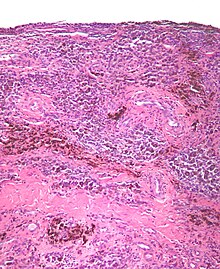Tenosynovial Giant Cell Tumor

Tenosynovial giant cell tumor (TGCT) is a group of rare, typically non-malignant tumors of the joints. TGCT tumors often develop from the lining of joints (also known as synovial tissue).:100:245
Common symptoms of TGCT include swelling, pain, stiffness and reduced mobility in the affected joint or limb.:102 This group of tumors can be divided into different subsets according to their site, growth pattern, and prognosis.:361 Localized TGCT is sometimes referred to as giant cell tumor of the tendon sheath;:100 diffuse TGCT is also called pigmented villonodular synovitis (PVNS).:102
Classification
Classification for TGCT encompasses two subtypes that can be divided according to site – within a joint (intra-articular) or outside of the joint (extra-articular) – and growth pattern (localized or diffuse) of the tumor(s).:100:361 Localized and diffuse subsets of TGCT differ in their prognosis, clinical presentation, and biological behavior, but share a similar manner of disease development.:100
Localized TGCT

Localized TGCT is sometimes referred to as localized pigmented villonodular synovitis (L-PVNS), giant cell tumor of the tendon sheath (GCT-TS), nodular tenosynovitis, localized nodular tenosynovitis, and L-TGCT.:1:100
The localized form of TGCT is more common.:100:245 Localized TGCT tumors are typically 0.5 cm-4 cm),:101 develop over years,:100 are benign and non-destructive to the surrounding tissue, and may reoccur in the affected area.:101 The most common symptom is painless swelling.:101 Localized TGCT most often occurs in fingers, but can also occur in other joints.
Diffuse TGCT

Diffuse TGCT is sometimes referred to as pigmented villonodular synovitis (PVNS), conventional PVNS, and D-TGCT.:1:361:1:102
Diffuse TGCT occurs less frequently and is locally aggressive (in some cases, tumors may infiltrate surrounding soft tissue).:245:1:102:1 It most commonly affects people under 40 years old, though the age of occurrence varies.:102 Diffuse TGCT may occur inside a joint (intra-articular) or outside of a joint (extra-articular). Intra-articular tumors typically occur in the knee (approximately 75% of cases) and hip (approximately 15% of cases).:102 Extra-articular tumors are usually found in the knee, thigh, and foot.:101 Symptoms include swelling, pain, sensitivity, and/or limited range of motion.:102 The rate of reoccurrence is estimated to be 18-46% for intra-articular tumors and 33-50% for extra-articular tumors.:103:1
Complications
Diffuse TGCT is locally aggressive and can spread to surrounding tissues, causing bone erosion and tissue damage. If not treated early, it can spread to areas outside the joint, extra-articular, and potentially cause permanent loss of range as well as intense pain.
Mechanism
TGCT tumors grow due to genetic overexpression of colony stimulating factor 1. This causes colony-stimulating factor-1 receptor (CSF1R) cells to accumulate in the joint tissue.
Diagnosis
TGCT can be diagnosed by magnetic resonance imaging (MRI), by biopsy, or during surgery. The disorder is difficult to identify and is often not diagnosed for years due to nonspecific symptoms or a general paucity of symptoms. TGCT cases are often misdiagnosed as osteoarthritis, localized trauma, sports injuries, xanthomas, or other conditions. One study of 122 diffuse TGCT patients found that the average delay in diagnosis was 2.9 years.
Treatment
Surgery has been the most common form of treatment for both localized:101:361 and diffuse TGCT.:103:361:1 After surgery, patients may receive physical therapy in order to help rehabilitate affected joints. However, recurrence of TGCT after surgery is common, with a higher rate of recurrence for diffuse TGCT than for localized TGCT.:361 In cases of recurrent or resistant disease, multiple surgeries, total joint arthroplasties, or amputation may be required.:1
A multidisciplinary approach, supplementing surgery with radiotherapy or other treatments, can also improve outcomes in cases of recurrent TGCT. In the late 2010s, treatment with CSF1R inhibitors emerged as an option that may help improve functionality for patients with recurrent TGCT or TGCT that is not easily managed by surgery.:361
Epidemiology
A study conducted in the Netherlands estimated that the worldwide incidence of TGCT is 43 cases per million person-years. The majority – 39 cases per million person-years – were estimated to be localized TGCT; the remaining 4 cases per million person-years were estimated to be diffuse TGCT. TGCT can occur in patients of any age, but people with localized TGCT are typically between 30 and 50 years old,:100–101 while diffuse TGCT tends to affect people under the age of 40.:102–103
See also
- Fibroma of tendon sheath
- List of cutaneous conditions